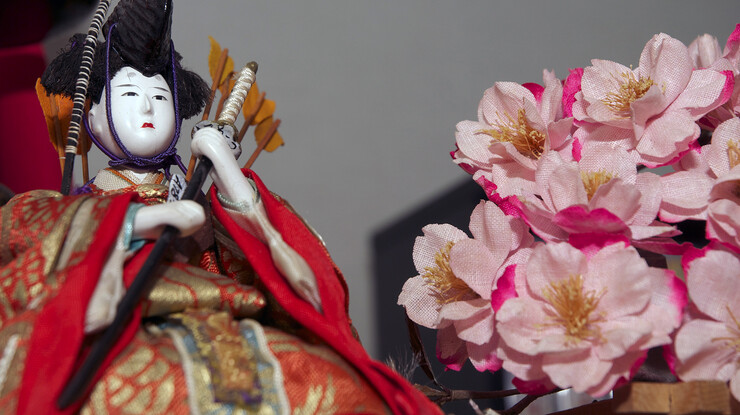· 3 min read
Japanese dolls span continents, centuries

The Kawasaki Reading Room features an array of Japanese cultural touchstones, from media and books to historical artifacts – and a new addition to its collection is not only a reference to a Japanese holiday and its ancient culture, but also a testament to friendships shared between continents.
Officials from the Lentz Center for Asian Studies approached Madoka Wayoro, director of the Kawasaki Reading Room, on the third floor of the Jackie Gaughan Multicultural Center, to see if officials there were interested in displaying some of the artifacts from its permanent collection. Among them: a set of Hinamatsuri Dolls, which are steeped Japanese tradition.
The 15 miniature porcelain dolls in the collection represent the emperor, empress, attendants and musicians in an ancient Japanese royal court. They are dressed in silk, adorned with miniature, ornate accessories and are seated among miniature replicas of furniture, lanterns, flags and other objects on a five- or seven-step platform.
The dolls were donated to the university by Columbus native and world traveler Florence Brugger, who received them as a gift from a Japanese friend, Nobuko Takeuchi during a Red Cross assignment in Hishinomiya in 1947. Despite their native countries having just been at war, the two became lifelong friends.
According to records at the Lentz Center, the dolls were first temporarily displayed in an exhibit at the Nebraska State Museum in Morrill Hall in 1978. They became the permanent property of the Lentz Center in 1987, shortly before Brugger’s death.
Wayoro said the original platform had been damaged over the years but Santiago Cal, associate professor of art and art history, built a new platform so the dolls can be displayed properly.
Hinamatsuri originated in ancient times when straw dolls were floated down a river to the sea, believed to take troubles and bad spirits with them. Today, Japanese culture suggests that each infant girl is given a set of the dolls to display each year for Girls’ Day on March 3. Much like Americans decorate for the winter holidays, the dolls are put out for display about a month before the holiday, but they must be taken down by March 4 or the girl may have a late marriage. The Japanese celebrate Girls’ Day with a festival that includes traditional food and drink.
Wayoro said having the dolls adds to the reading room’s educational value. She is making plans for the reading room to host a Girls’ Day festival in March and she also hopes to add an event to celebrate Children’s Day on May 5.
In contrast to Japanese tradition, Wayoro said the dolls will be on permanent display so that visitors can enjoy them year-round.
“Our goal is to build bridges between Japanese and American cultures,” Wayoro said. “These dolls convey Japanese culture, tradition and background so we are happy to have them.”









